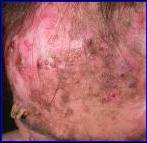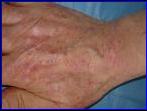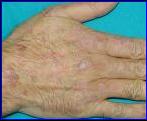
|
Epidermodysplasia Verruciformis |
|
Epidermodysplasia Verruciformis (EV) is a rare inherited disease characterized by an increased susceptibility to infection by Papillomaviruses of the Beta genus (β-HPV), which mainly infect the skin. EV starts during childhood with the appearance of multiple flat warts and maculo-papular lesions in sun-exposed sites, like the forehead. During the first decades of life, such lesions can give rise to precancerous elements or even full-blown cutaneous neoplasms. EV was first described in 1922 by Levandowski and Lutz, and provides a unique model of HPV-induced skin carcinogenesis and thus a valuable opportunity to study the link between infection and carcinoma formation. The literature reports that about 10% of EV cases are born within consanguineous marriages and that 10% of such families present more than one affected sibling. These data strongly point to a recessive autosomal inheritance of the disease. Recently, two different genetic susceptibility loci were identified; the most important loci is EV1 that comprises the genes EVER1 and EVER2, and for which many genetic mutations have been reported. EV patients frequently present a state of immunodeficiency, above all caused by defects in cell-mediated immunity (T cell immunity). The diagnosis of EV is based purely on clinical observations, and is suspected in subjects showing numerous (either isolated or confluent) flat warts, erythemato-squamous lesions on the trunk or precancerous elements, such as multiple actinic keratoses or cutaneous neoplasms, primarily localized to sun-exposed areas. EV provides a unique human model in which to study the various factors responsible for HPV mediated skin carcinogenesis; indeed, 100% of cutaneous tumors taken from EV patients are positive for β-HPV infection. So far, no specific diagnostic test is available for EV; the only test that can be performed is the histological examination of warty lesions. In the Department of Clinical and Experimental Medicine in Novara, a combination of molecular assays were performed in a group of EV patients in order to properly investigate and quantify β-HPV infection. The same assays have also proved to be useful for EV diagnosis, even in paucilesional and clinically uncertain cases. These assays represent a step forward in EV diagnostics and follow-up and their aim is to increase our knowledge of this rare, orphan disease. |




|
Precancerous and neoplastic lesions in the forehead, forearms and dorsum of the hands in patients suffering from Epidermodysplasia Verruciformis. |


